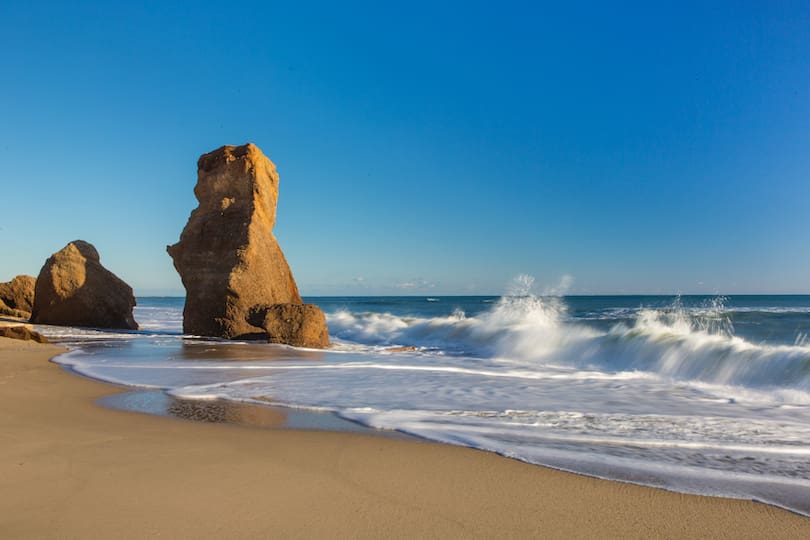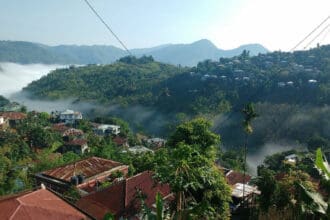Nestled in the heart of the Thar Desert, Khimsar is a small yet enchanting town located approximately 90 kilometers from Jodhpur in Rajasthan. Known for its rich history, royal heritage, and serene landscapes, Khimsar offers a perfect blend of culture, tradition, and natural beauty. This quaint destination is often overlooked by mainstream tourists, making it an ideal spot for those seeking a tranquil escape amidst Rajasthan’s vibrant charm. In this article, we will explore the top 5 places to visit in Khimsar , delving into their historical significance, architectural brilliance, and cultural importance. Let’s embark on a journey to uncover the hidden treasures of this desert oasis.
1. Khimsar Fort: A Timeless Emblem of Rajput Legacy
Historical Background
Khimsar Fort , one of the most iconic landmarks in the region, dates back over 450 years. Built in 1523 by Rao Karamsji, the eighth son of Rao Jodha, the founder of Jodhpur, the fort served as a strategic military outpost and later as a royal residence. Over the centuries, it has been meticulously preserved and transformed into a luxury heritage hotel, offering visitors a chance to experience the grandeur of Rajasthan’s royal past.
Architectural Marvels
The fort is a stunning example of Rajput architecture, characterized by its massive walls, towering bastions, and intricate carvings. The interiors are equally impressive, with ornate frescoes, mirror work, and traditional Rajasthani motifs adorning the walls and ceilings. One of the standout features of Khimsar Fort is its Sheesh Mahal (Mirror Palace) , where thousands of tiny mirrors create a dazzling effect when illuminated.
The courtyards of the fort are spacious and serene, with lush gardens, fountains, and shaded alcoves providing a perfect setting for relaxation. Visitors can also explore the royal chambers, prayer halls, and banquet halls, each of which reflects the opulence and sophistication of a bygone era.
Visitor Experience
Today, Khimsar Fort operates as a luxury heritage hotel, allowing guests to immerse themselves in the regal ambiance. Even if you’re not staying overnight, you can book a guided tour to explore the fort’s interiors and learn about its fascinating history. Don’t miss the opportunity to enjoy a traditional Rajasthani meal in the fort’s dining hall, where the ambiance is as memorable as the cuisine.
For photography enthusiasts, the fort offers endless opportunities to capture its beauty. The interplay of light and shadow on the frescoes and the reflection of the fort in the surrounding water bodies create mesmerizing visuals.
2. Sand Dunes of Khimsar: A Slice of the Thar Desert
Introduction to the Sand Dunes
The sand dunes of Khimsar are a must-visit attraction for anyone traveling to this desert town. Located just a short drive from the main village, these golden dunes offer a quintessential Thar Desert experience. Unlike the more commercialized dunes near Jaisalmer, Khimsar’s sand dunes are relatively untouched, providing a serene and authentic desert adventure.
Activities and Experiences
Visitors can enjoy a variety of activities, including camel safaris, jeep rides, and quad biking across the dunes. For a more immersive experience, many operators offer overnight camping under the stars, complete with bonfires, folk music, and traditional Rajasthani meals. The tranquility of the desert at night, with its clear skies and twinkling stars, is truly magical.
The sand dunes are also a great spot for photography, especially during sunrise and sunset when the golden hues of the sun bathe the landscape in a warm glow. Whether you’re an amateur or professional photographer, the dunes provide countless opportunities to capture stunning visuals.
Cultural Significance
The Thar Desert has long been an integral part of Rajasthan’s cultural identity, shaping the lifestyle and traditions of its people. The sand dunes of Khimsar offer a glimpse into this unique way of life, with local communities still practicing age-old customs and crafts. Visitors can interact with the locals, learn about their traditions, and even purchase handmade souvenirs like embroidered textiles and pottery.
3. Khimsar Village: A Glimpse into Rural Rajasthan
Overview of the Village
Khimsar Village is a charming settlement that offers a glimpse into the rural life of Rajasthan. Surrounded by vast stretches of desert and farmland, the village is home to friendly locals who are eager to share their stories and traditions with visitors. It’s a place where time seems to stand still, and the pace of life is refreshingly slow.
Local Attractions
One of the highlights of visiting Khimsar Village is exploring its vibrant markets, where you can find a variety of handicrafts, textiles, and jewelry. The village is particularly known for its block-printed fabrics and lacquerware , which make for excellent souvenirs. You can also visit local temples and stepwells, which are not only religious sites but also architectural marvels.
Cultural Experiences
For a deeper understanding of the region’s culture, consider participating in a village safari. These guided tours take you through the countryside, where you can interact with farmers, artisans, and shepherds. You’ll have the opportunity to witness traditional farming techniques, learn about local crafts, and even try your hand at pottery or weaving.
The village also hosts cultural performances, such as folk music and dance, giving guests a glimpse into Rajasthan’s rich artistic heritage. These performances are often accompanied by traditional meals, adding to the overall experience.
4. Black Buck Wildlife Sanctuary: A Haven for Nature Lovers
Location and Accessibility
Located just a few kilometers from Khimsar, the Black Buck Wildlife Sanctuary is a protected area dedicated to the conservation of the endangered blackbuck antelope. Spread across 25 square kilometers, the sanctuary is home to a variety of flora and fauna, making it a paradise for nature lovers and wildlife enthusiasts.
Wildlife and Flora
The sanctuary is primarily known for its population of blackbucks, which are easily spotted grazing in the open grasslands. Other animals you might encounter include chinkaras (Indian gazelles), nilgais (blue bulls), and desert foxes. Birdwatchers will also be delighted by the variety of avian species, including peacocks, partridges, and migratory birds.
The vegetation in the sanctuary consists mainly of thorny bushes and grasslands, typical of the arid desert landscape. The stark beauty of the terrain, combined with the sight of graceful blackbucks, creates a surreal and unforgettable experience.
Visitor Guidelines
Visitors to the sanctuary are advised to hire a local guide, who can help spot wildlife and provide insights into the ecosystem. Safaris are conducted in jeeps, ensuring minimal disturbance to the animals. Early morning and late afternoon are the best times to visit, as the wildlife is most active during these hours.
5. Stepwells of Khimsar: Hidden Gems of Hydraulic Engineering
Introduction to Stepwells
Stepwells, or baolis , are an integral part of Rajasthan’s architectural heritage, serving as both water reservoirs and social spaces. Khimsar is home to several ancient stepwells, each with its own unique design and historical significance.
Architectural Features
One of the most notable stepwells in Khimsar is the Khimsar Baoli , a multi-storied structure with intricately carved pillars and staircases. The stepwell is designed to allow easy access to water, even during the driest months. Its symmetrical design and geometric patterns reflect the ingenuity of ancient hydraulic engineering.
Another lesser-known but equally fascinating stepwell is the Jain Baoli , located near the village outskirts. This stepwell is adorned with sculptures and carvings depicting scenes from Jain mythology, making it a significant religious site as well.
Cultural Importance
Stepwells were not just functional structures; they also served as gathering places for women, who would collect water and socialize. During festivals and ceremonies, these spaces would come alive with music, dance, and rituals. Today, they stand as reminders of the region’s rich cultural heritage and sustainable practices.
Visitor Guidelines
Exploring the stepwells of Khimsar is a rewarding experience, offering a glimpse into the region’s history and traditions. Visitors are advised to wear comfortable footwear, as the staircases can be steep and uneven. Guided tours are available, providing insights into the stepwells’ construction and significance.
Why Khimsar Should Be on Your Travel Bucket List
Khimsar may not be as famous as other destinations in Rajasthan, but it is a hidden gem waiting to be discovered. Its rich history, vibrant culture, and architectural wonders make it a compelling choice for travelers seeking an off-the-beaten-path experience. Whether you are exploring the majestic Khimsar Fort, relaxing amidst the serene sand dunes, or marveling at the intricate stepwells, Khimsar offers a wealth of attractions that cater to diverse interests.
In addition to its historical and cultural significance, Khimsar is also known for its warm hospitality and delicious cuisine. Local delicacies like dal baati churma, gatte ki sabzi, and ker sangri are sure to tantalize your taste buds. Moreover, the village’s bustling markets offer a variety of handicrafts, textiles, and jewelry, making it a paradise for shoppers.
“Khimsar is not just a destination; it is an experience that stays with you long after you leave.”
Conclusion
Khimsar is a town that effortlessly blends the old with the new, offering visitors a chance to step back in time while enjoying modern comforts. Its top 5 places to visit —Khimsar Fort, the sand dunes, Khimsar Village, the Black Buck Wildlife Sanctuary, and the stepwells—are testaments to its rich heritage and cultural diversity. Each of these attractions has its own unique charm, making Khimsar a destination that deserves a spot on every traveler’s itinerary.
Whether you are planning a weekend getaway or an extended vacation, Khimsar promises an unforgettable experience. Its serene landscapes, vibrant traditions, and warm-hearted people will leave you with memories to cherish for a lifetime. So pack your bags, hit the road, and embark on a journey to discover the hidden treasures of Khimsar.
FAQs
- What is the best time to visit Khimsar?
- The best time to visit Khimsar is between October and March when the weather is pleasant.
- How do I reach Khimsar?
- Khimsar is located approximately 90 km from Jodhpur and is well-connected by road. Private taxis and buses are readily available.
- Are there any accommodation options in Khimsar?
- Yes, Khimsar offers a range of heritage hotels, including Khimsar Fort, catering to different budgets.
- Is Khimsar safe for solo travelers?
- Yes, Khimsar is considered safe for solo travelers, including women.
- What are some local dishes to try in Khimsar?
- Must-try dishes include dal baati churma, gatte ki sabzi, and ker sangri.
- Can I hire a guide to explore Khimsar’s attractions?
- Yes, local guides are available and can provide valuable insights into the town’s history and culture.
- Are there any shopping options in Khimsar?
- Yes, Khimsar is known for its handicrafts, textiles, and jewelry.
- Is photography allowed at the historical sites?
- Photography is generally allowed, but it is advisable to check with authorities at specific sites.
- What is the significance of the stepwells in Khimsar?
- The stepwells are examples of ancient hydraulic engineering and served as water reservoirs and social spaces.
- Are there any annual festivals in Khimsar?
- Yes, festivals like Teej and Gangaur are celebrated with great enthusiasm.















